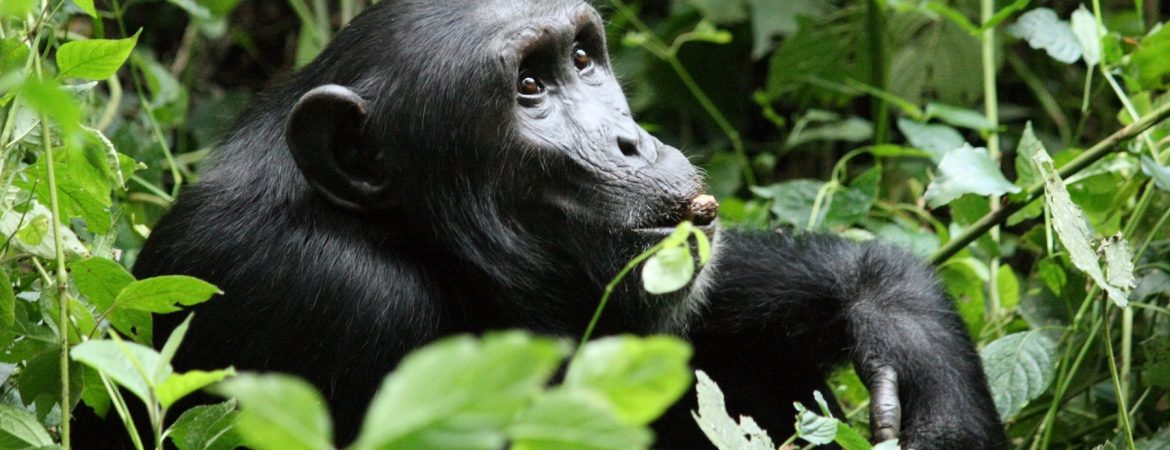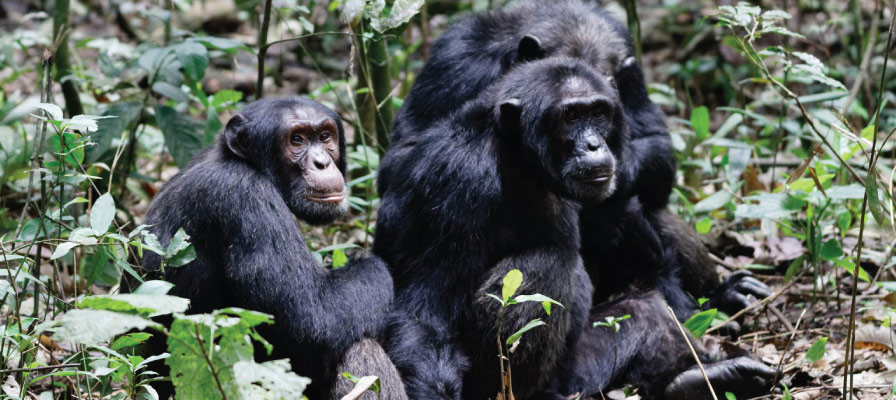Chimpanzee Habituation Experience : Chimpanzees are hominids a group that consists of all modern and extinct Great Apes. Four species of chimpanzees are known and all of these exist in Africa.

These four species are the eastern, western, central, and Nigerian-Cameroon chimpanzees. The eastern chimpanzee is a species that lives in many African countries including Uganda, Rwanda, Democratic Republic of Congo (D.R.C), Burundi, Tanzania, Central African Republic (C.A.R), and Sudan.
Uganda is the highest primate habitat in Africa with about 20 primate species. Of these, 13 are diurnal and 7 are nocturnal species. The most sought-after in this list are the mountain gorillas and the chimpanzees of Bwindi Impenetrable National Park and Kibale National Park respectively.

Travelers who intend to undertake primate safaris and tours visit Uganda for mainly gorilla tracking and chimpanzee tracking. Not very common and yet more fascinating among these activities are the exciting gorilla habituation and chimpanzee habituation activities.
Chimpanzee habituation is the gradual process of introducing/making wild chimpanzees familiar and comfortable with human presence. Other than the standard chimp tracking, travelers interested in spending more time with the chimps opt for the chimp habituation activity.
Chimp habituation is more strenuous compared to chimp tracking because it’s a half-day experience where trackers have to walk deeper into the forest where the non-habituated chimps live and the activity is exclusive to Kibale National Park. The park is home to 13 primate species of which about 1,500 are chimps.
During chimpanzee habituation, trackers join primatologists, researchers, and rangers as they go into the forest to meet the chimps and the activity is limited to only four people per group, inclusive of the researchers. The activity starts as early as 6:00 am when the chimps are leaving their overnight nests. You will watch them descend the trees and come to the ground to feed, copulate, breastfeed, play and go about their daily routine until 12:00 pm when they climb back to the trees to rest.
Chimp habituation takes about 3 years for the chimps to get fully accustomed to human presence. The chimpanzee habituation permit costs 250 USD and the fee caters to the guide and entrance to the park. It is always advisable that visitors book their chimpanzee habituation permits in advance.
Facts about Chimpanzees
Chimpanzees are our closest living relatives.
It is believed that humans and chimps descended from a common ancestor that lived about 7 million years ago. Coupled with the fact that chimps move more by climbing and swinging but also knuckle-walking and in some incidences on two feet, it is no doubt that they are our closest living relatives.
Chimpanzees are highly intelligent.
Chimpanzees have been seen using self-made tools such as sticks to withdraw termites from their mounds, stones to crack and open hard nuts, and leaf sponges to collect drinking water. It was also observed that these traits were most common in chimpanzees that walked a long distance in the wild.
Chimpanzees are endangered.
Worldwide, chimpanzees are estimated to be between 170,000 and 300,000 individuals. This dwindling figure put chimpanzees on the IUCN Red List as endangered. Chimpanzees also have a slow reproductive rate where most females bear a baby once every 5 years. The dwindling figure is also a result of threats such as poaching and habitat loss due to logging plus diseases which contribute to the mortalities.
Chimpanzees are omnivores.
The biggest proportion of a chimp’s diet is composed of bits of plant materials for example seeds, roots, small branches, and resin among others. To complement their diet, chimps also eat bird eggs, and small mammals like antelopes, insects, and honey.
Chimpanzees live in groups
Family groups vary in size from 15 to 150 individuals. The group is strictly led by a male who protects the rest of the family from danger and ensures peace and harmony among members. Being social animals, chimps can wander in other groups during the day to forage and join their families later.
Live up to 40 years
The life expectancy for male chimps is 31 whereas that for females is 39. This figure is relatively higher for chimpanzees in captivity. This is a result of the better diet and medical attention they receive in captivity.
Have an estrus cycle.
Just like female humans, chimpanzees have an estrus cycle that comes about once every month.

Have the ability to learn human languages.
Chimpanzees in captivity have been seen picking up American Sign Language (ASL) when communicating with their caretakers. Washoe – a female chimpanzee was the first non-human to learn and communicate more than 350 signs using American Sign Language. She also taught some of these signs to her adopted son. Those are some of the facts of the chimps so for more information just have a Uganda safari and habituate the lovely creatures in order to know more about them.
Best time for Chimpanzee Habituation Experience
Chimpanzee Habituation Experience is an all-year-round activity. However, for the best experience, it is recommended to undertake it during the wet season in the months of March, April, May, and November. During this time, there is plenty of food for the chimps and therefore they do not move deep in the forest thus making it easier for the trackers to locate them. However, this season receives a lot of rainfall therefore it’s advisable to carry warm clothing, a waterproof polythene bag to protect your equipment like cameras and phones, and a waterproof jacket.
During the dry season, there is less mud thus less difficult to walk through the forest trails in search of the chimpanzees. Unlike mountain gorillas, chimpanzees are very playful and noisy, with occasional loud barks and hoots from dominant males and other members of their community which will lead trackers to where they are thus easier to locate.
What to pack for a chimpanzee habituation tour
A proper packing list as well matter for the habituation tour in Uganda due to the surprising weather changes now days, and these are some of the things you should consider to carry along with you for the tour:
Waterproof daypack
Camera without flashlight
Long sleeved shirt
Insect repellents
Energy giving snacks
Plenty of bottled drinking water
First aid kit
Gardening gloves
Valid passport and visa
Sun glasses
Hat
Sweater
Gorilla habituation permit


